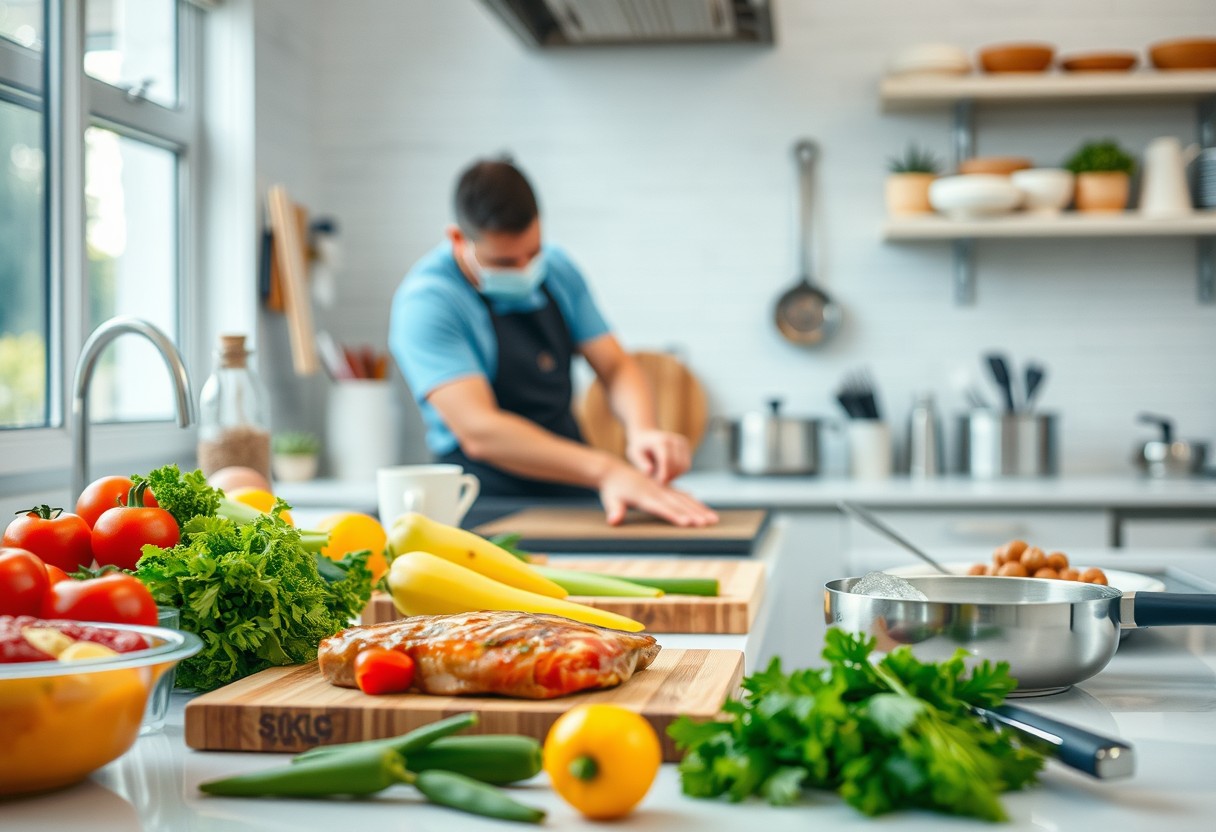Just imagine enjoying a delicious meal only to be struck down by food poisoning. To prevent this unfortunate scenario, it’s crucial to understand the common causes and effective prevention strategies. You can significantly reduce your risk by practicing proper food handling, cooking, and storage techniques. In this guide, you will discover important tips to keep your meals safe and enjoyable, ensuring that your dining experiences remain delightful rather than hazardous.
Key Takeaways:
- Practice Proper Hygiene: Always wash your hands thoroughly with soap and water before handling food, after using the restroom, and after touching raw meat.
- Cook Food Thoroughly: Ensure that all meats, poultry, seafood, and eggs are cooked to their recommended internal temperatures to kill harmful bacteria.
- Store Food Safely: Refrigerate perishable items promptly and maintain your fridge at a temperature below 40°F (4°C) to prevent bacterial growth.
- Avoid Cross-Contamination: Use separate cutting boards and utensils for raw meats and ready-to-eat foods to reduce the risk of spreading bacteria.
- Be Cautious with Expiration Dates: Check expiration dates on food products and consume or discard items accordingly to avoid eating spoiled or unsafe food.
Understanding Food Poisoning
To effectively avoid food poisoning, it’s important to first understand what it is. You may encounter various contaminants in food, and knowing their causes can empower you to make safer choices. For more insights, check out How to avoid food poisoning – PMC.
Definition and Causes
For a clear definition, food poisoning occurs when you ingest contaminated food or beverages, leading to various gastrointestinal issues. Common causes include bacteria, viruses, parasites, and chemical contaminants.
Common Types of Foodborne Illness
The common types of foodborne illness can impact your health in significant ways. Understanding these illnesses is crucial for preventive measures:
- Salmonella
- Norovirus
- Escherichia coli (E. coli)
- Listeria monocytogenes
- Clostridium perfringens
This list highlights prevalent sources of foodborne pathogens. Refer to the following for more detailed information:
| Type of Illness | Common Source |
| Salmonella | Poultry, eggs, unpasteurized milk |
| Norovirus | Contaminated water, leafy greens |
| E. coli | Undercooked beef, contaminated vegetables |
| Listeria | Soft cheeses, deli meats |
| Clostridium perfringens | Meat dishes, gravies |
Foodborne pathogens can result in a variety of health issues, which makes it important to stay informed. Here are a few more details about common types of foodborne illness:
- Campylobacter jejuni
- Hepatitis A
- Staphylococcus aureus
- Vibrio
- Clostridium botulinum
This underscores the need for vigilance in your food handling practices. Consider the following breakdown:
| Type of Illness | Common Source |
| Campylobacter | Poultry, unpasteurized milk |
| Hepatitis A | Contaminated food or water |
| Staphylococcus | Improperly stored food |
| Vibrio | Undercooked seafood |
| Botulism | Improperly canned goods |
Symptoms and Effects on Health
To identify food poisoning, you should be aware of the common symptoms. These can include nausea, vomiting, diarrhea, abdominal cramps, and fever.
The severity of symptoms can vary based on the pathogen involved and your overall health. Understanding these effects is pivotal for recognizing potential food poisoning and seeking timely medical assistance when necessary.

Preventative Measures in Food Preparation
If you want to minimize the risk of food poisoning, it’s vital to adopt preventative measures during food preparation. Being diligent about hygiene and cooking practices ensures that your meals are safe and healthy.
Proper Handwashing Techniques
With a proper handwashing technique, you can eliminate many harmful bacteria. Always wash your hands with soap and water for at least 20 seconds before handling food, especially after using the restroom or touching raw ingredients. Don’t forget to wash between your fingers and under your nails for optimal cleanliness.
Safe Food Handling Practices
Proper food handling practices are important to prevent contamination. Always use clean utensils, cutting boards, and surfaces, and designate separate items for raw and cooked foods.
Techniques such as keeping raw meat away from other foods, using separate cutting boards, and storing food at safe temperatures help maintain a safe kitchen environment. Always defrost foods in the refrigerator, microwave, or cold water, never at room temperature. Adopting these practices can significantly reduce the risk of cross-contamination.
Cooking Temperatures and Methods
Food safety relies on cooking foods at appropriate temperatures. Use a food thermometer to ensure that meats reach the recommended internal temperatures, which helps kill harmful bacteria.
| Food Type | Minimum Internal Temperature (°F) |
|---|---|
| Poultry | 165°F |
| Ground Meat | 160°F |
| Steaks and Roasts | 145°F |
| Fish | 145°F |
Measures such as using slow cookers to reach safe temperatures gradually, or avoiding practices like reheating leftovers improperly, are crucial for ensuring food safety. Always double-check cooking times and methods, as this can be the difference between a safe meal and foodborne illness.
Cross-Contamination Awareness
Any kitchen should prioritize cross-contamination awareness. This means understanding that raw foods, especially meat, can transfer harmful bacteria to ready-to-eat foods if they come into contact.
Another critical aspect of this is replacing or sanitizing surfaces, utensils, and containers that have come into contact with raw foods immediately. The importance of proper storage can’t be overstated, either; always store raw meats on the lowest shelves in the fridge to prevent drips onto other foods. Taking these precautions will greatly reduce the chances of food poisoning in your kitchen.
Storage and Preservation of Food
All foods require proper storage and preservation methods to ensure their safety and longevity. Following the right practices can effectively minimize the risk of foodborne illnesses and protect your health. Understanding how to properly refrigerate, assess expiration dates, and handle freezing and thawing will arm you with the knowledge needed to keep your food safe.
Optimal Refrigeration Practices
Refrigeration is crucial for maintaining food safety. Ensure your refrigerator is set at or below 40°F (4°C) to slow bacterial growth. Store raw meats on the bottom shelf to avoid cross-contamination and utilize airtight containers for leftovers to maintain freshness. Remember to check the temperature regularly, as even small fluctuations can impact food safety.
Understanding Expiration Dates
The importance of expiration dates cannot be overstated. These dates provide a guideline for consumers regarding the safety and quality of food products. While “sell by” dates refer to how long a product is expected to remain on store shelves, “use by” dates indicate the last day the manufacturer guarantees optimal freshness.
For instance, many products, such as canned goods and dry staples, can be safe to consume after their expiration dates if they have been stored properly. However, it is crucial to evaluate the food for any signs of spoilage, including odor, discoloration, or unusual texture before consuming. Trust your instincts and prioritize your health.
Freezing and Thawing Safely
Any food that you don’t plan to consume shortly should be frozen to extend its shelf life. Make sure to use airtight containers or freezer bags to prevent freezer burn and preserve quality. Label your packages with the date to keep track of how long items have been stored.
This includes thawing frozen foods safely, which you can accomplish in the refrigerator, in cold water, or in the microwave. Never thaw food at room temperature, as it promotes bacterial growth. Always cook thawed food promptly, and avoid refreezing unprepared items to reduce the risk of contamination.
Eating Out and Food Safety
Despite the convenience and enjoyment of dining out, it’s imperative to remain vigilant about food safety to avoid food poisoning. Being aware of how to select safe eating establishments and knowing the potential risks involved can significantly reduce your chances of falling ill. For comprehensive guidelines on best practices, you can refer to the resource on How to Prevent Food Poisoning.
Choosing Safe Restaurants
For choosing a safe restaurant, you should prioritize those with a good reputation for cleanliness and proper food handling practices. Look for places that have high sanitation ratings and positive customer reviews about the quality of their food. Don’t hesitate to ask staff questions about food preparation and ingredients to ensure your dining experience is as safe as possible.
Awareness of Foodborne Risks in Dining
Eating out can expose you to foodborne illnesses if you are not aware of potential hazards. It’s important to recognize factors such as cross-contamination in the kitchen, improper food storage temperatures, and undercooked dishes, which can all contribute to the risk of food poisoning.
Safe preparation practices are crucial in restaurants, but awareness of how these risks manifest can significantly help you make informed choices. Observe how staff handle food, the cleanliness of the kitchen visible from your table, and whether they follow safety protocols. If something feels off, it’s reasonable to choose another dining option.
Reporting Illnesses from Food Consumption
Awareness of how to report foodborne illnesses is critical for improving overall food safety. If you fall ill after eating out, make sure to inform the restaurant about your experience, as they might not be aware of the issue. Reporting can help them identify and rectify potential problems in their food handling processes.
Risks associated with foodborne illnesses do not only affect you; they can have widespread consequences if not addressed. By reporting your illness, you not only contribute to the safety of future diners but also support the restaurant in maintaining high food safety standards. In a communal effort, this helps reduce the chances of others experiencing similar experiences.
FAQ
Q: What are the best practices for food storage to prevent food poisoning?
A: To prevent food poisoning, it’s crucial to follow effective food storage practices. First, always refrigerate perishable foods within two hours of purchasing or cooking them. Ensure your refrigerator is set to 40°F (4°C) or below. Store raw meat, poultry, and seafood separately from other foods to avoid cross-contamination, preferably in sealed containers. Additionally, use airtight containers for leftovers, and label them with dates to ensure they are consumed within a safe timeframe, ideally within 3-4 days. Regularly check your pantry and refrigerator for expired items and clean them out promptly.
Q: How can I ensure my food is cooked safely to reduce the risk of food poisoning?
A: Cooking food to the right temperature is crucial for killing harmful bacteria that can cause food poisoning. Use a food thermometer to check the internal temperatures: poultry should reach 165°F (74°C), ground meats should be cooked to at least 160°F (71°C), and whole cuts of meat, including beef, pork, lamb, and veal, should reach 145°F (63°C) with a three-minute rest time. Additionally, be sure to wash hands, utensils, and surfaces after handling raw meats and before preparing other ingredients to prevent cross-contamination. Remember to avoid eating raw or undercooked eggs, seafood, and meats.
Q: What steps should I take when handling food to minimize the risk of food poisoning?
A: When handling food, practicing good hygiene and safety measures is key to minimizing the risk of food poisoning. Start by washing your hands thoroughly with soap and warm water for at least 20 seconds before preparing or consuming food. Always use separate cutting boards for raw meats and ready-to-eat foods, and avoid using the same utensils without washing them in between. Be mindful of your cooking environment by cleaning countertops, cutting boards, and utensils after each use with hot soapy water. Make sure to keep foods out of the “danger zone” (between 40°F and 140°F or 4°C and 60°C) to inhibit bacterial growth, and avoid leaving perishable foods out for more than two hours.


